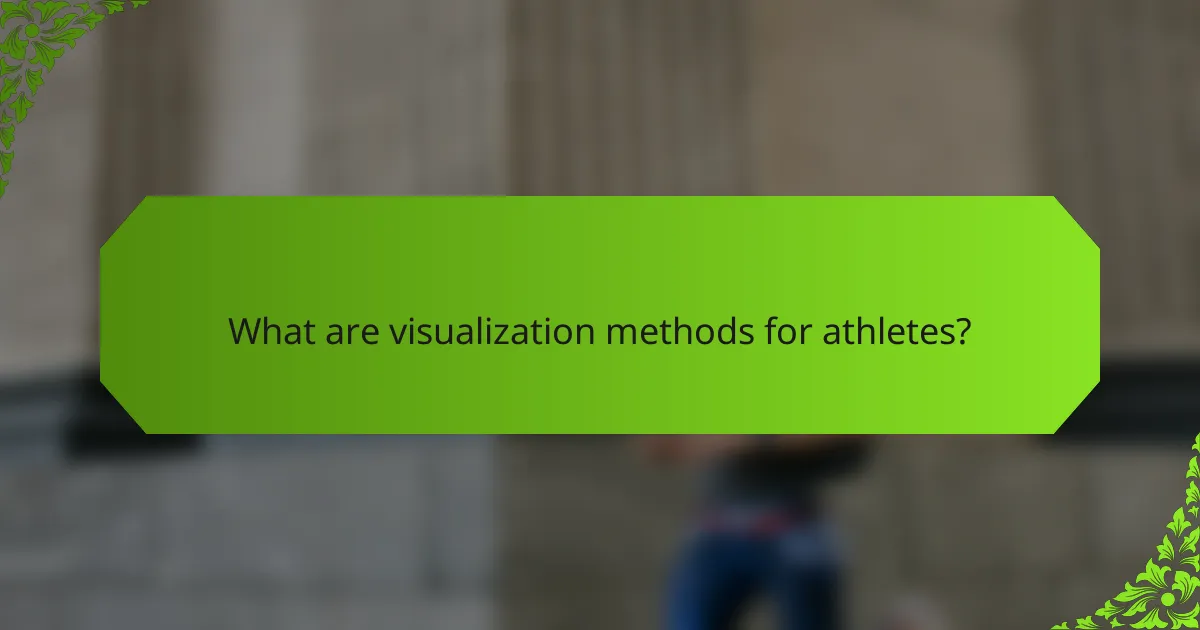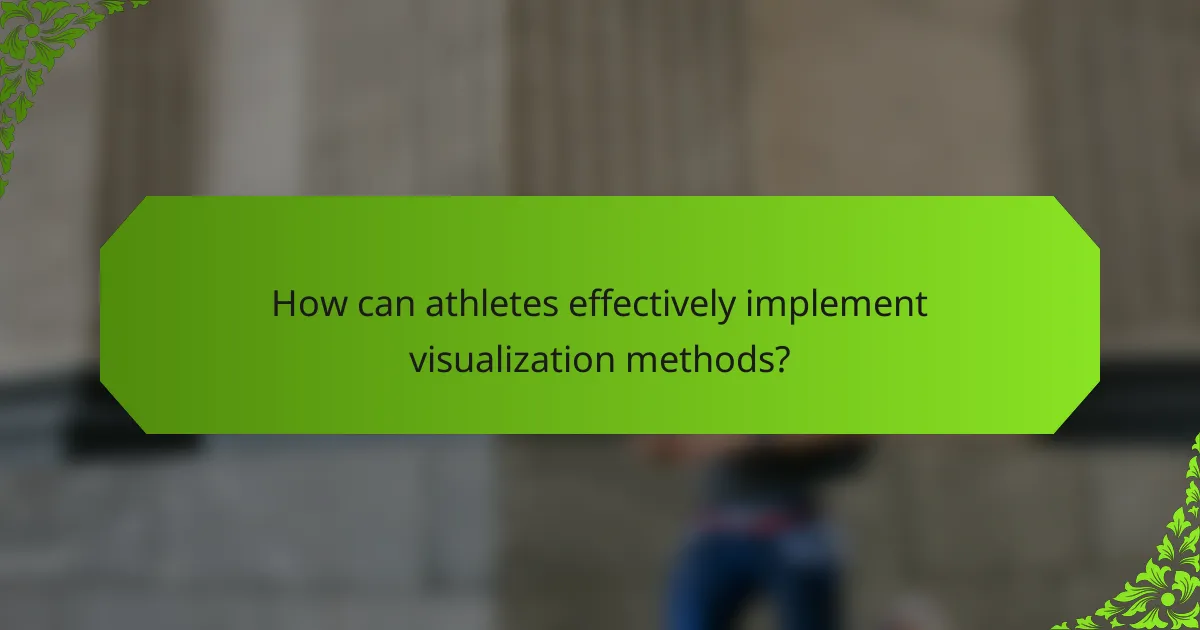Visualization methods for athletes significantly enhance performance by improving focus, confidence, and emotional regulation. Techniques like guided imagery and mental rehearsal foster grit and mental clarity. Research shows these methods activate brain regions similar to physical practice, reinforcing skills and reducing anxiety. Unique practices, including sensory immersion and virtual reality, offer innovative ways to engage athletes’ mental game.

What are visualization methods for athletes?
Visualization methods for athletes enhance mental resilience and focus. Techniques such as guided imagery, where athletes visualize successful performances, improve confidence and reduce anxiety. Mental rehearsal allows athletes to practice skills mentally, reinforcing muscle memory. Additionally, visualization can include sensory experiences, enhancing emotional engagement. Research shows these methods can significantly improve performance outcomes.
How do visualization methods enhance athletic performance?
Visualization methods significantly enhance athletic performance by improving focus and mental resilience. These techniques help athletes mentally rehearse their actions, leading to better execution during competition. For instance, studies show that athletes who practice visualization experience reduced anxiety and increased confidence. This mental training fosters grit, allowing athletes to push through challenges and maintain clarity under pressure. By incorporating visualization, athletes can optimize their performance and achieve their goals more effectively.
What psychological principles underlie visualization techniques?
Visualization techniques enhance athletes’ mental resilience and focus through principles like cognitive rehearsal and the law of attraction. Cognitive rehearsal allows athletes to mentally practice skills, reinforcing neural pathways and boosting performance. The law of attraction posits that positive visualization can manifest desired outcomes, fostering motivation and grit. These psychological principles create a robust framework for athletes to improve mental clarity and achieve their goals.

What are the universal benefits of visualization for athletes?
Visualization enhances athletes’ performance by improving focus, confidence, and emotional regulation. It allows athletes to mentally rehearse their routines, leading to increased grit and mental clarity. Research indicates that visualization can activate similar brain regions as actual physical practice, reinforcing skills. Athletes using visualization report reduced anxiety and enhanced motivation, contributing to overall performance improvement.
How does visualization improve focus and concentration?
Visualization enhances focus and concentration by creating mental imagery that aligns with athletic goals. This technique fosters mental clarity and grit, allowing athletes to visualize success and improve performance. Research indicates that visualization activates the same brain regions as actual physical practice, reinforcing neural pathways. As a result, athletes experience heightened concentration and a more profound commitment to their training.
In what ways does visualization boost confidence?
Visualization enhances confidence by allowing athletes to mentally rehearse success and develop a strong sense of self-efficacy. This technique cultivates grit and mental clarity, enabling athletes to focus on their goals and overcome challenges. Research shows that visualization activates the same neural pathways as actual performance, reinforcing skills and reducing anxiety. Regular practice of visualization can lead to improved resilience and a positive mindset, essential for peak performance.
How can visualization techniques help in injury recovery?
Visualization techniques significantly enhance injury recovery for athletes by improving mental resilience and focus. These methods foster a positive mindset, which is crucial during rehabilitation. Visualization can reduce anxiety and increase motivation, allowing athletes to mentally rehearse movements and strategies. Research indicates that athletes who utilize mental imagery experience faster recovery times and improved performance outcomes. This unique attribute of visualization establishes it as a powerful tool in sports psychology, aiding athletes in overcoming the psychological hurdles of injury.

What unique visualization techniques are popular among elite athletes?
Elite athletes often use visualization techniques like mental imagery, guided visualization, and video analysis to enhance performance. These methods boost grit and mental clarity by fostering focus and reducing anxiety. Mental imagery involves vividly imagining successful performances, while guided visualization includes listening to scripts that create a mental rehearsal environment. Video analysis allows athletes to visualize techniques and strategies, enhancing understanding and retention. These unique approaches contribute significantly to an athlete’s mental game, setting them apart in competitive environments.
How do Olympic athletes use visualization in their training?
Olympic athletes use visualization to enhance focus and mental resilience. They mentally rehearse their performance, creating vivid images of success. This technique boosts confidence and helps manage anxiety, leading to improved execution during competitions. Visualization also aids in goal-setting, allowing athletes to align their training with desired outcomes. By integrating this method into their routines, athletes develop a competitive edge through enhanced mental clarity and grit.
What role does guided imagery play in sports visualization?
Guided imagery enhances sports visualization by enabling athletes to mentally rehearse performance scenarios. This technique boosts grit and mental clarity, helping athletes visualize success and overcome obstacles. Research shows that athletes using guided imagery report improved focus and reduced anxiety, which are crucial for peak performance. By creating vivid mental images, athletes can enhance their motivation and confidence, leading to better outcomes in competitions.

What rare visualization practices can athletes explore?
Athletes can explore rare visualization practices like sensory immersion, where they engage all five senses in their mental imagery. This method enhances emotional connection, potentially increasing motivation and performance. Another practice is guided imagery with a focus on overcoming specific obstacles, helping athletes mentally rehearse solutions. Additionally, using virtual reality for immersive visualization offers a unique experience, allowing athletes to simulate competition environments. Engaging in creative visualization techniques, such as storytelling, can also foster deeper mental clarity and resilience.
How do athletes utilize virtual reality for visualization?
Athletes utilize virtual reality for visualization to enhance mental clarity and build resilience. This technology allows them to simulate real-life scenarios, improving focus and decision-making. By immersing themselves in these environments, athletes can visualize their performance, practice techniques, and reduce anxiety. Research indicates that VR training can lead to increased grit, as athletes repeatedly face challenges in a controlled setting, reinforcing their mental toughness.
What are the benefits of integrating biofeedback with visualization?
Integrating biofeedback with visualization enhances athletes’ mental resilience and focus. This combination allows athletes to monitor physiological responses, improving their ability to visualize success and maintain clarity under pressure. Biofeedback provides real-time data, enabling athletes to adjust their mental imagery techniques for optimal performance. As a result, athletes experience increased motivation and reduced anxiety, fostering a stronger mental state during competition.

How can athletes effectively implement visualization methods?
Athletes can effectively implement visualization methods by regularly practicing mental imagery techniques. This enhances focus, boosts grit, and improves performance under pressure.
1. Set clear goals: Define specific outcomes to visualize, such as winning a race or executing a perfect routine.
2. Create vivid mental images: Engage all senses to form detailed scenarios, making the experience as realistic as possible.
3. Practice consistently: Dedicate time daily to visualization, integrating it into training routines.
4. Use relaxation techniques: Combine visualization with deep breathing or meditation to enhance mental clarity.
5. Review and adjust: Reflect on visualizations to refine techniques and adapt to changing goals or challenges.
What are the best practices for daily visualization routines?
Daily visualization routines for athletes should focus on consistency and clarity. Start each session by setting clear goals and intentions. Use imagery that is vivid and specific to enhance mental clarity. Incorporate various techniques such as guided imagery, mindfulness meditation, and performance scripts.
Engage all senses in the visualization process to create a more immersive experience. Track progress and adjust routines based on what enhances mental resilience and focus. Regular practice can significantly boost grit, leading to improved athletic performance.
What common mistakes should athletes avoid when visualizing?
Athletes should avoid common mistakes like lack of specificity, negative imagery, and inconsistent practice. Being vague in visualization can lead to unclear mental images. Negative imagery can create self-doubt, undermining confidence. Inconsistent practice reduces effectiveness; regular visualization enhances mental clarity and grit.
How can athletes measure the effectiveness of their visualization techniques?
Athletes can measure the effectiveness of their visualization techniques by tracking performance metrics and self-assessment scores. Regularly evaluating these factors helps identify improvements in focus and grit. Incorporating feedback from coaches enhances the assessment process. Utilizing tools like journals or apps can provide structured insights into mental clarity and visualization impact on training outcomes.
What metrics can be used to evaluate visualization success?
To evaluate visualization success for athletes, consider metrics such as engagement levels, performance improvements, retention of information, and emotional responses. These metrics provide insights into the effectiveness of visualization methods in enhancing grit and mental clarity.
| Metric | Description |
|————————–|———————————————-|
| Engagement Levels | Measure how actively athletes interact with visualizations. |
| Performance Improvements | Assess changes in athletic performance post-visualization. |
| Retention of Information | Evaluate the ability to recall visualized concepts over time. |
| Emotional Responses | Analyze athletes’ emotional reactions to visualizations. |
What expert insights can enhance visualization strategies?
Expert insights can significantly enhance visualization strategies for athletes by focusing on mental resilience and clarity. Techniques such as guided imagery can improve focus and reduce anxiety, fostering a stronger mental state. Incorporating biofeedback tools allows athletes to visualize their physiological responses, optimizing performance through self-awareness. Additionally, utilizing virtual reality can create immersive environments, enhancing the realism of practice scenarios. These innovative methods not only boost grit but also sharpen mental clarity, leading to improved athletic outcomes.


